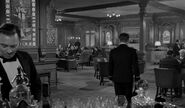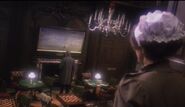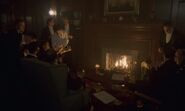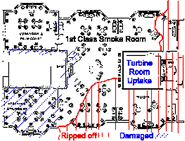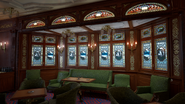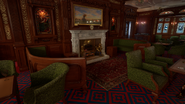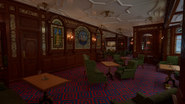The First-Class Smoking Room, located on A Deck off the Aft Grand Staircase landing was a "late night" lounge where First Class male passengers could congregate, socialize, discuss matters of business/politics, smoke, drink and play games of chance (except on Sundays).
In keeping with social conventions of the time, the room was exclusive to men. In order to recreate the same atmosphere of a gentlemen's club, the room was decorated with dark mahogany paneling inlaid with mother-of-pearl and richly carved. Numerous large stained-glass windows were installed in pediment-ed niches within the paneling, illuminated from behind. Like the Lounge, the ceilings and windows were raised above the level of the Boat Deck for increased height and the room was flanked by alcoves with bay windows, also in stained-glass.
The floor was laid with blue and red linoleum tiles and the plaster ceiling was molded with plaster medallions. In the center of the far-back wall was a Norman Wilkinson painting, Plymouth Harbour, which hung over a coal-burning fireplace in white marble. This was the only real fireplace on board: the others were installed with electric heaters. Square tables with raised edges (to prevent drink spillage in rough weather) dotted the room, surrounded by round club chairs upholstered in leather, of an unknown color (probably green or burgundy).
To the right of the fireplace was a revolving door which led to the Verandah Café. The room was U-shaped because the ventilation shaft from the Turbine Engine Room occupied the forward end and to vent out smoke from the fireplace & cigars. This area also included bathrooms.
The Smoking Room was the preferred spot of gamblers who crossed the Atlantic. Professional card sharps also traveled on board under aliases, and the purser could do nothing but warn passengers about these swindlers, since passengers played at their own risk. At least four professional players travelled on board the Titanic. Cigars and drinks could be made available upon request of the passengers and were provided by the stewards of the adjacent bar. The bar opened at 8:30 A.M. and stopped serving at 11:30 P.M. and the Smoking Room itself closed at midnight.
It was in this room that William Thomas Stead quietly read a book during the sinking. Also in this room, standing at the fireplace, was the ship's designer Thomas Andrews reportedly seen here shortly before the ship foundered; this story, which was published in a 1912 book (Thomas Andrews: Shipbuilder), came from John Stewart, a steward on the ship who in fact left the ship in Lifeboat 15 at approximately 1:45 A.M. However, a contradictory account by Cecil William Fitzpatrick places Andrews on the bridge just before the Titanic sank.
Later, just before 2:00 A.M. Archibald Gracie entered the room. He found Major Archibald Butt, Francis Davis Millet, Clarence Moore, and Arthur Ryerson playing a last hand of cards at their usual table. William Stead still sat at his chair reading his book. Nearby, Emil Taussig, the manager of the West Disinfecting Company, sat alone in a chair with his hands cupped in his lap, looking down at the ground, seemingly in a state of calm and acceptance of what was happening. At around 2:05 A.M., the cardplayers shook hands and left the room, with Millet and Major Butt staying behind and apparently jumping overboard together. Archibald Gracie left the room; therefore, it is not known what happened to Mr. Taussig and Mr. Stead, but we do know they perished in the sinking.
On Britannic, the smoke room took an L shape and had a different design, with a different floor, different room style and skylights.
Wreck[]
The Smoking Room was destroyed during the sinking, being located just aft of where the break-up occurred in an area that was ripped apart during the stern's plunge to the sea floor. No pictures of the Titanic's Smoking Room are known, only those of the Olympic. Certain artefacts have been recovered from the debris field which once decorated the room, including two of the gilt-bronze chandeliers, and portions of the red and blue linoleum floor tiles.
The raised roof and walls of this room were torn away with the fourth funnel deckhouse. The back wall of the Second Class Entrance remains. The turbine uptake was also torn away from this room.







